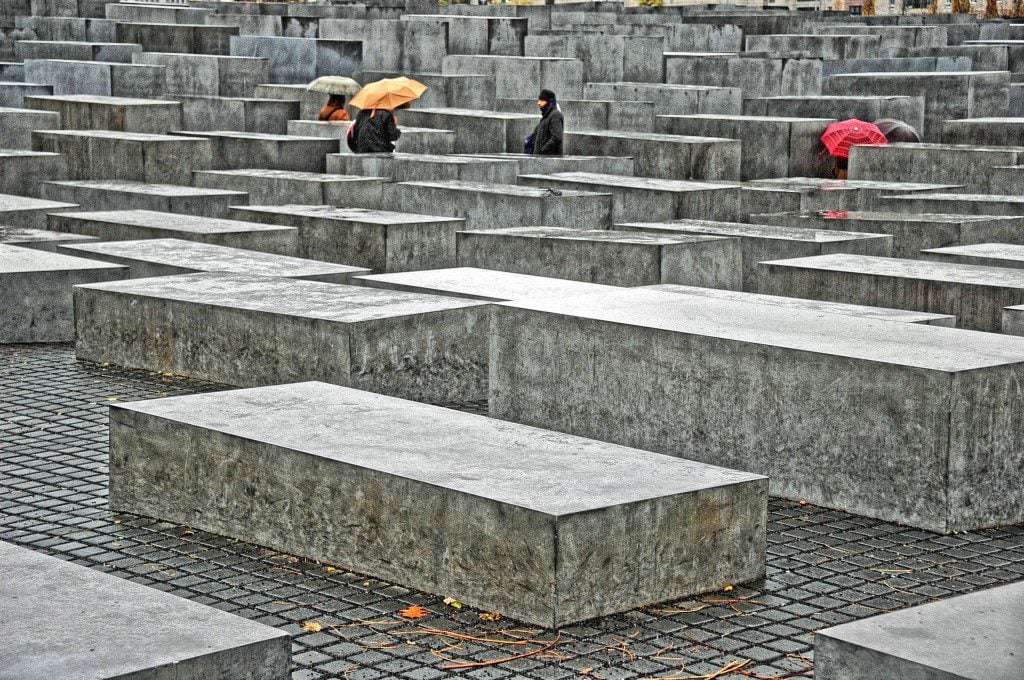OK, one might say, “Timothy Snyder gets it wrong on the Holocaust” but no one knows who Snyder is, and it was, in the end, Slate that chose to publish this article, “History’s True Warning; How our misunderstanding of the Holocaust offers moral cover for the geopolitical disasters of our time.”
The article, by a professor of history at Yale, makes the claim that the “statelessness” of Eastern Europe was what caused, or at least enabled, the Holocaust. He starts with an individual, who as a prewar policeman in Germany, had helped a Jewish cantor and his family escape across the border to France in the aftermath of Kristallnacht, but then joined the SS, and, as a member of an Einsatzgruppe, participated in mass murder, killing Jews in shootings and via gas van.
But Snyder’s explanation for how this man, and so many others, became murders, acting in the cause of eliminating the Jews, seems far-fetched: he attributes it to statelessness, saying that when the Germans invaded Poland and the Soviet Union, they created conditions of anarchy, insofar as he characterizes what the Germans were doing as ” undo[ing] European states” — and further characterizes the situation their as lawless, that is, “In a land without laws, German policemen were willing to shoot Jews, thousands at a time, people who were accused of no crime.”
Then Snyder says,
Jews who lived before the war in places that became stateless had about a 1-in-20 chance of surviving. Elsewhere in places under German control, even in Germany itself, the probability was more like 1-in-2. The entirety of the killing would take place in a zone of Eastern Europe where the Germans brought anarchy.
So, look, yes, he’s a professor of history at Yale, and I’m, well, an armchair historian. But I have read enough about the Holocaust (and trust me, I really have read a lot) to be highly suspicious of his characterization.
Is it appropriate to label the Eastern European conquests of the Nazis as “stateless” and “anarchic”? It is true that they did treat them differently than the Western Europe conquests, where a greater semblance of local (collaborationist) control was retained, because the Nazi’s racism extended beyond antisemitism to considering Slavs as inferior races as well — their fate was not immediate extermination, but the Nazis nonetheless intended that they ultimately shrink greatly in number and form a minimally-educated servant class for the Germans. And why were the killing camps located in Poland, rather than spread out, so as to be able to kill, say, Dutch Jews, in place? I’ve always understood this to be a matter, first, of the high Jewish population in Poland, and, second, as again a matter of German’s different attitudes toward the Dutch (civilized) and Poles (not inhuman like the Jews, but a lower sort of human). Also, the camps’ location in Poland meant that the Germans were able to delude Western European Jews as to their fate, keeping up the charade up to the moment of entry into the gas chamber; when the Poles arrived at Sobibor, in contrast, the Germans used brutality instead.
If you want to label occupied territories as “stateless,” that’s just a matter of definition, but I would hardly characterize occupied Poland as anarchic. After all, the mass killings were not the actions of rogue soldiers empowered by the chaos around them, but directives from on high. The German occupying forces maintained tight control; it was only in places without such tight control, such as the forests, where Jews and partisans were able to hide with much success.
And why were deaths so much higher in Poland? Let’s start by saying that Snyder’s statement that elsewhere, and even in Germany, the probability of surviving was 1 in 2, doesn’t make sense to me — perhaps, with respect to Germany, he considers the pre-Hitler Jewish population, many of whom managed to leave Germany in the very early Nazi years, but once the war started? Lucy S. Dawidowicz’s The War Against the Jews, 1933 – 1945, which was the seminal work when I was in college back years ago and has made it through many bookshelf cullings since then, says that (to select a few countries) 90% of the Jewish population was killed in Poland, the Baltic States, Germany/Austria, and the “Protectorate” (that is, the Czech half of Czechoslovakia), 75% in the Netherlands, 70% in Hungary, 60% in Belgium. True, in France, only 26% were killed, and in Italy, only 20%.
Looking at Germany more specifically, according to the US Holocaust Museum website, of a pre-Nazi popluation of 522,000, more than half, 304,000 emigrated (though they didn’t all escape, as many landed elsewhere in Europe, like the Franks). Of the remaining 214,000 at the beginning of the war, all but 20,000 were deported by 1943, and those who remained were either of mixed ancestry, married to non-Jews, or went into hiding. By wars end, 160,000 – 180,000 of these 214,000 had been killed — so a figure of 75% to 84%, not counting (I think) those deported from the European countries they had emigrated to.
But the reasons were varied. In Poland and the Soviet Union, most Jews lived apart, and the net was drawn around them so tightly that there was no escape, and little means of going into hiding. Local antisemitism meant that their neighbors were often willing to turn them in for the sake of some extra cash, and the Ukrainians in particular were quite willing to help the Nazis. Jews in Germany and Austria were often first deported to Polish ghettoes, from which they had even less ability to escape. In the Netherlands, Jews were more integrated into the community, and better able to obtain false papers or find hiding places. In Hungary, the local regime was able to protect the Jews until 1944, so there was a wholly different dynamic. In France, it seems to me that unoccupied France was able to protect “its” Jews and only surrender for deportation those who were immigrants from elsewhere, though I’m not certain, and Mussolini (I think) had no interest in the Nazis’ killing project.
In none of these situations do I see a scenario of statelessness causing or abetting the Holocaust.
So why does Snyder take this wholly revisionist approach? Possibly because that’s what Yale historians do — perhaps this is just another example of the constant need to say something “new.” But his ultimate desire in his Slate article is to use the Holocaust as a way of commenting on present-day world affairs.
Snyder says:
A large body of scholarship on ethnic cleansing and genocide concludes that mass killing generally takes place during civil wars or regime changes. Nazi Germany deliberately destroyed states and then steered the consequences toward Jews. Destroying states without such malign intentions creates the space for the kind of disaster that continues to unfold in the Middle East: in its civil wars, religious totalitarianism, and refugee crisis.
So his first statement sounds reasonably correct — it’s been my understanding that the Holocaust stood as the exception to the general rule, and that the ethnic cleansing that took place as Yugoslavia collapsed is more typical. (I’ve got a book out from the library about the Armenian Genocide, at the moment, after which I should understand better how that fits in.) The second statement — that Nazi Germany “steered the consequences” — seems to miss the point that Nazi Germany actively implemented the Holocaust rather than simply creating conditions in which the locals did the shooting of their own initiative. And the third sentence is simply trying to find “lessons of history” to support his own present-day political viewpoint.
Now, history offers a great many lessons. It teaches, most of all, that there are consequences, some predictable, and some unpredictable, on a grand scale. But it can’t be reduced to a single “lesson” applicable in all times and places, past and present.











